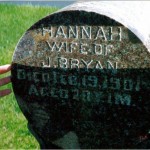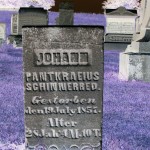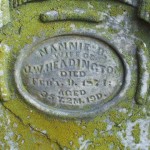Cemeteries are some of my favorite places to visit. It doesn’t make any difference if I have family buried in a particular cemetery or whose tombstone I am looking at, I enjoy looking at and photographing tombstones.
I have been photographing tombstones for some time now and have hundreds of tombstone photographs. Some of those photographs have turned out well, others, not so much.
How can you safely read and photograph a stone that is weathered and dirty? The Association of Gravestone Studies recommends very few things to safely clean a tombstone and make it readable. They advise against using most chemicals, soaps, acids or anything that is abrasive. You should not use flour, shaving cream or sidewalk chalk either.
Below are a few techniques I have used over the years for viewing and photographing grave markers without harming them.
1. In my opinion the most important thing for getting a good tombstone reading and photograph is the position of the sun on the stone. A bright sunny day is best and the sun should be shining on the stone at about a 30 degree angle. For a stone facing west this time of day would occur from about 12:30-2:30. Late morning would be best for a stone facing east.

Tombstone of Johann Georg Schumm (1777-1846), Zion Lutheran Cemetery, Schumm, Ohio. Photographed at 1:58 p.m., 8 Aug 2008.
2. If you are at the cemetery at the wrong time of day or if the writing on the stone faces north you can use a mirror to reflect the sun’s light. This technique works very well and if done properly looks like a spotlight shining on the marker. If you are taking a photo of the stone you will probably need another person to hold the mirror. Although a mirror works best, any very reflective surface will also work. Cardboard covered with aluminum foil or a shiny windshield reflector both work.

Grave marker of Hannah Bryan (1830-1901), Limberlost Cemetery, Jay County, Indiana. Mirror illuminating inscription that faces north.
3. Just squirting plain water on the stone might make the engraving stand out. I always carry a squirt bottle of water in my cemetery bag. Yes, I have a cemetery bag packed and always ready to throw in my car trunk for graveyard visits.
4. Sometimes you can read a tombstone inscription better from a photograph. Inverting the colors in your photo program will make the image look like a negative and bring out the lettering. Enlarging and enhancing the photo on your screen may also help.

Johann Pantkraeius Schinnerred (sic) (1829-1857), Zion Lutheran Cemetery, Schumm, Ohio. Colors inverted.
5. The tombstone may need to be cleaned if it is covered with moss or some other biological growth. But be careful! It is best to use plain water and a soft nylon brush or sponge. If necessary, use one cup of household ammonia in a gallon of water to clean a tombstone. Use only soft nylon brushes or natural sponges. Do not use wire brushes since the metal may become embedded in the stone and rust. The Association of Gravestone Studies has a website and booklets that detail a few other ways to clean stubborn deposits from tombstones.
Tombstones could be considered historical artifacts. They may contain the only recorded information about an individual. Read and record the information on a tombstone but at the same time be careful not to damage the stone so future generations can also view and learn from them.
There are still plenty of nice late summer and autumn days left to visit to a cemetery and I hope to do just that.





12 comments
Skip to comment form
Great tips. I’m recommending members in my genealogy group visit this article of yours. Many thanks and Happy Root Diggin”
Robin [ o ]”
Author
Thank you! I should add something else, that I recently read about but haven’t tried yet: shining an LED flashlight across the tombstone. I saw photos of this recently on Facebook and it looks like a great way to read a weathered stone. They said a light with at least 1700 lumens works best. I plan to get one soon and try it out. If successful, I will probably write about it and show examples.
oh goodness, this is awesome! Thanks for providing this often overwhelming information in such an understandable format.
Author
Thank you and thanks for reading.
I totally agree that the crucial factor in a tombstone reading is the position of the sun on the stone. My granny has just passed away and we need to think both about the funeral service and the details like cemetery lettering. Thanks for the advice!
Author
So sorry to hear about the passing of your grandmother. I am glad you find the tombstone information useful and thanks for writing!
You are right about the sun angle being important. You can’t always get that, however. I have had great results using off-camera flash. You put the flash across the stone at an angle. With this, you can get the shot you want anytime of day or night, and on stones where you thought you would never be able to read anything, sometimes, it makes the writing appear like magic. The technique sounds a little scary for some people, but if you already have a nice camera, you have no excuse not to try this. Just search “Tombstones off-camera flash” in a search engine.
Author
Thank you for explaining this technique. It sounds very good and I will definitely try it. Thanks for writing!
I liked that you pointed out that a squirt bottle can help you manage any cleaning you need to do to a gravestone. That is good for me to know because my family is trying to figure out what tombstone to get my great aunt. She is going to buried in a place that has a lot of birds flying over and a lot of natural erosion. So we will need to clean it every now and then.
Author
Thank you!
It is cool seeing old tombstones. Thanks for pointing out that you will want to try inverting the colors on old stones that you are having trouble reading. My mom wants to go take pictures of all of her family members’ gravemarkers. Personally, I would want to also know about getting some of the older ones restored a bit.
Author
Thank you! Taking photos of all family gravestones is a great idea. I have tried to do that myself. It is important to get those photos while you can. Thanks for writing.